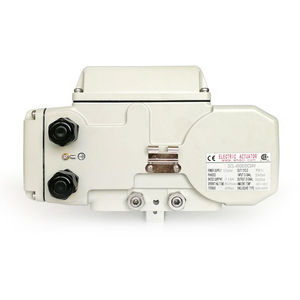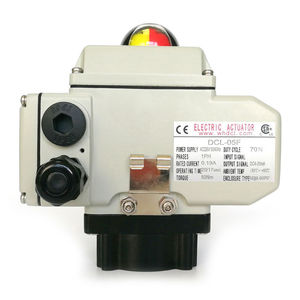
- Hydraulics - Pneumatics
- Valve
- Electric valve actuator
- Dynamic Corporation Limited

- Products
- Catalogs
- News & Trends
- Exhibitions
Electric valve actuator DCL seriesquarter-turnworm gearaluminum
Add to favorites
Compare this product
Characteristics
- Type
- electric
- Movement
- quarter-turn
- Technology
- worm gear
- Other characteristics
- aluminum, rugged, with integrated safety, single-phase, for high-torque applications
- Torque
Min.: 18 Nm
(13.28 ft.lb)Max.: 2,500 Nm
(1,843.91 ft.lb)
Description
Detailed Product Description
Power Supply: - 24VAC/110VAV/220VAC/380VAC/24VDC -
Installation Angle: - 360°
Standard Time/Torque: - 15S To 75S/18Nm To 2500Nm/160in.lbs To 22125in.lbs -
Total Weight: - 1.2KG To 20KG
Motor Power: - 6W To 140W -
Ambient Temperature: - -25℃~+55℃ / -13°F~+131°F
Protection Grade: - IP67 NEMA4/4X
Features
- Quarter turn with mechanical limits
- Two auxiliary limit switches to confirm valve position
- Rugged IP67 and NEMA 4X aluminum alloy enclosure with external power coated, resistance to neutral salt spray test for over 1000 hours
- Heavy duty motor with high starting torque and small inertia force
- Metal self-locking worm gear drive prevents back driving and hunting
- Visual valve position indicator
- Manual override with wrench or handwheel
- Standard ISO5211 direct installation
- CSA certified per UL 429 and CSA C22.2, CE mark
Description
DCL fail safe electric actuator can stay at last know position when power lose, to keep pipe flow and pipe pressure no change. All metal gear train can also suffer high pressure vibration when dangerous situations happen. Heavy duty motor can re-drive valve when power on. Over 10000 times full loaded life cycle with duty rate larger than 80%.
All actuators are rigorous tested and certified by CSA per UL and CSA standard, tested by SGS per CE and RoHS 3 standard.
Other Dynamic Corporation Limited products
Fail Safe Electric Actuator
*Prices are pre-tax. They exclude delivery charges and customs duties and do not include additional charges for installation or activation options. Prices are indicative only and may vary by country, with changes to the cost of raw materials and exchange rates.




